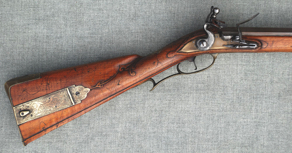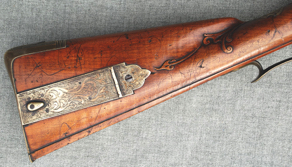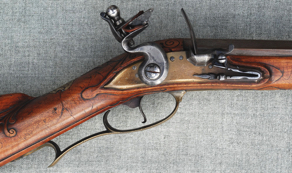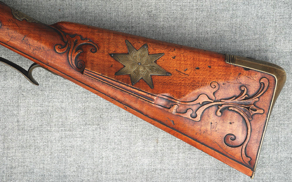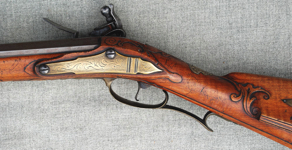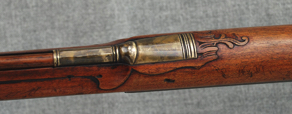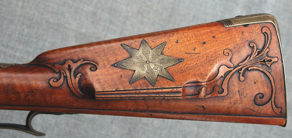I believe this piece to be a representative example of an American rifle built by a European-trained immigrant potentially dating to the 1750s. I've not attempted to ‘copy’ any single antique rifle nor assign any distinctly regional stamp, for a rifle of such an early period likely should not possess any regional tell. I believe that a rifle such as this may have been constructed anywhere in the colonies where a German-speaking gunstocker may have settled and commenced work, be it Bethlehem, Lancaster, the Shenandoah Valley or Bethabara. Could it have been stocked by Andreas Albrecht? Perhaps Matthias Roesser? Andreas Betz? Part of the charm and mystery surrounding such an interpretational arm is the vague or gnawing sense of not quite being able to put one’s finger on something.
Influencing the creation of this rifle are a very small pool of antique pieces: “Rifle 17” as illustrated in Shumway’s Rifles of Colonial America Vol. I (pg. 78-81), originally stocked in a similar straight-stock fashion and marked with an inscription indicating the year 1755 or 1756; the so-called “Musician Rifle” as preliminarily discussed in Wallace Gusler’s 2005 Muzzle Blasts series, “An 18th-Century Moravian Rifle Gun from North Carolina” which is secondarily-marked [I currently believe it to be an authentic marking] with “1756/NJ” and very likely is a 1750s-period rifle; finally, two extant box lids sharing very similar engraving style, “No. 47” as illustrated in Shumway’s RCA Vol. I (page 203) and a lid signed “Georg Leyendecher” and dated “1771” which is illustrated elsewhere within this site. These two boxes are obviously later than the 1755-1765 era, however I believe that the engraving style itself is a remnant of an earlier baroque, symmetrical type which represents a simplistic American approach to earlier European-style coverage. As Robert Weil has astutely noted, this is indeed a ‘what-if’ rifle in that I have attempted to present an interpretive piece which is firmly rooted in documented examples yet takes ample liberty with the large gaps in our current knowledge of 1750-1775 American rifles.
Overall, as much as I thoroughly enjoy antiquing a rifle along mental storylines and thus creating a heavily-aged photo album of a fictitious life, I decided not to age this piece quite so heavily. While it certainly appears to be an old and used rifle, it presents as such with the caveat that it has been well cared-for and constantly cleaned. Perhaps, given the extensive decoration, it was constructed for a wealthy individual and has not been exposed to severe usage. The Ed Rayl barrel is of a large breech and early nature, 48 inches in length and smoothbored at .62 caliber. The brass-plate flintlock is handmade and some may detect a hint of the signed “Albrecht . A . Bethleh:” lock remnant illustrated in Selected Articles from the KRA Bulletin (page 184-185), although the octagonal nose has considerable German precedent and is by no means unique to Albrecht’s early lock. In the tradition of nearly all early rifles, I have opted not to overtly mark or sign the exterior of the rifle.
